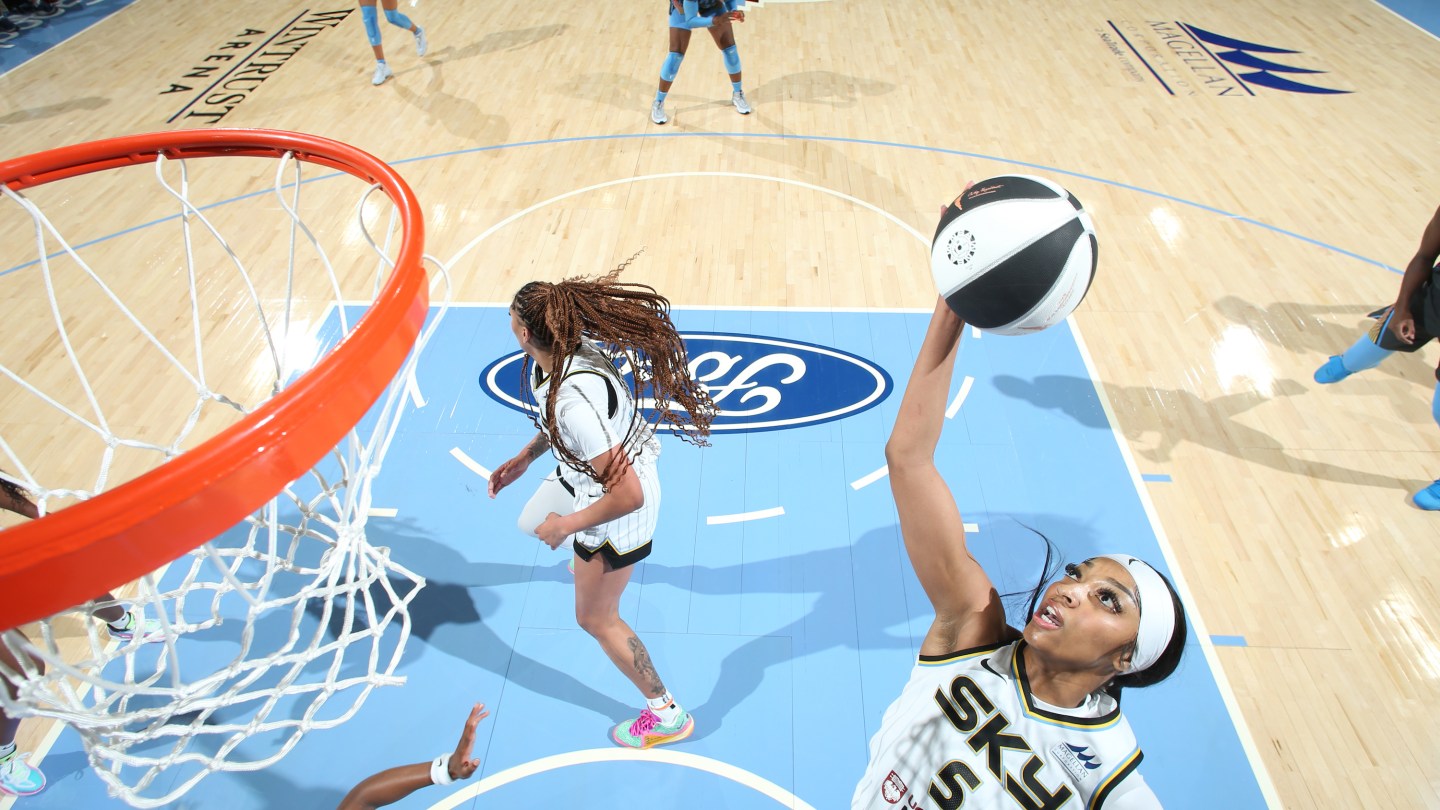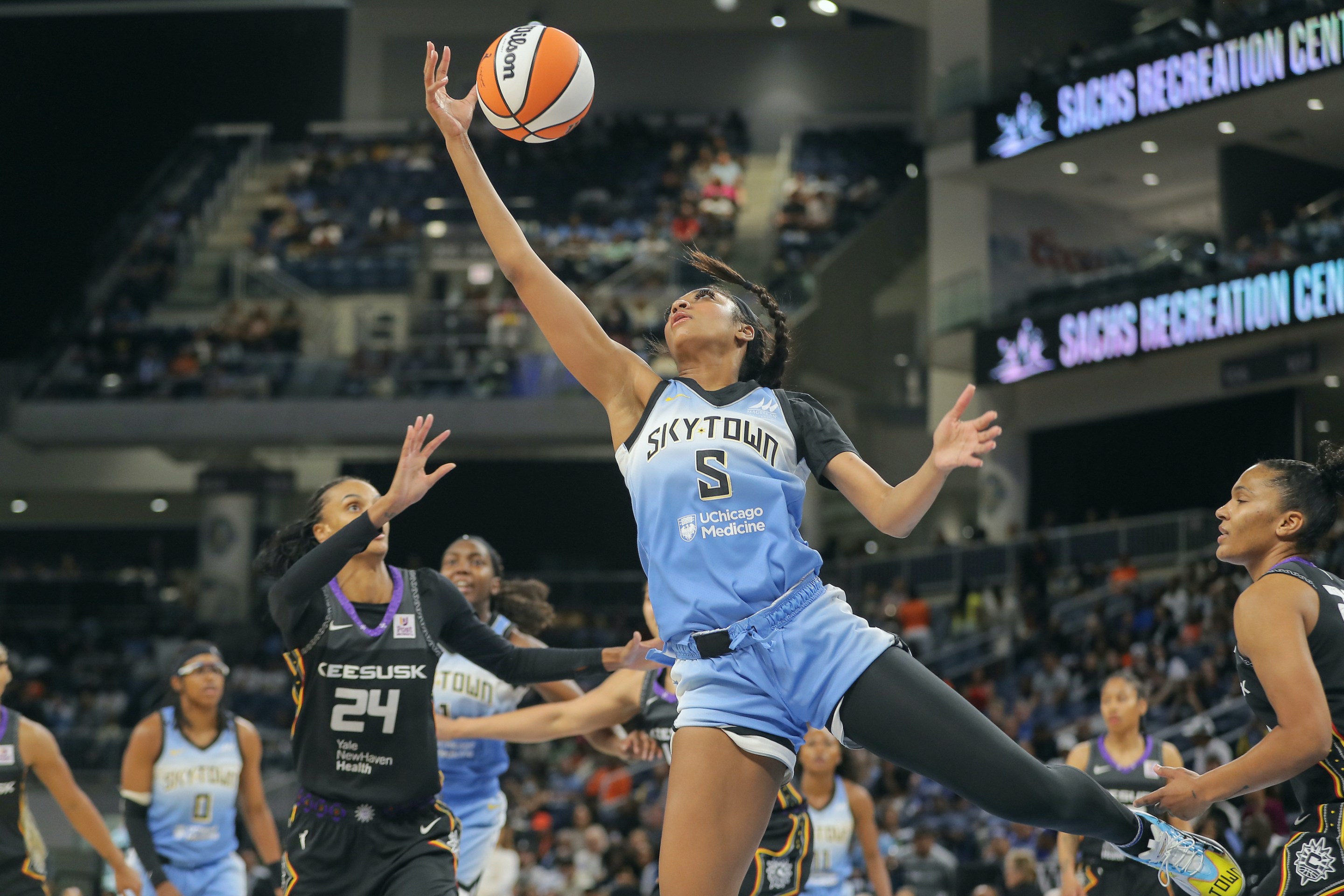Of the many impassioned words spilled on Angel Reese, maybe 5 percent have to do with the way she plays basketball. That balance isn’t wholly uninvited. Reese declared for this year's WNBA draft with a Vogue feature, styled in Ferragamo and Louboutin. On Instagram, where she has 3.4 million followers, her bio identifies her as co-owner of the DC Power women’s soccer club and "entrepreneur." Her social media posts are rich and oddly moving texts. In one tweet from May, she hits on lopsided WNBA media coverage, Seattle Storm rookie Nika Muhl’s early-season visa complications, and the league’s rollout of charter planes: “Get Nika her visa NOW, charter flights are HERE, give every team the same PUBLICITY cause it ain’t just one team, online bullying ain’t it AT ALL and oh the CHICAGO SKY ARE HERE & ON THE RISE! 😇” She might be the greatest poster of all time.
But if you actually watch Reese, as I did in Chicago earlier this June, the irony becomes apparent: For all her off-court glamor, the Sky’s 6-foot-3 rookie plays a remarkably hard-nosed game. She understands that basketball, at its core, is a 40-minute series of tiny opportunities, each of which can be seized by the person who wants it more. As a result, Reese is a cooler, weirder player than you could ever tell from the clips lazily dissected on morning talk shows. The last time Reese had played the league-leading Connecticut Sun, that night's opponent, the unforgiving Alyssa Thomas had thrown her down by the neck. If the memory haunted her at all, Reese didn't show it. She finished with 20 points on 8-of-10 shooting and 10 rebounds. The Sky lost the rematch, 83-75, but no one on the court worked harder or smarter. I began to dream big: How far could that take her?
To commit to the bit, to consider Reese purely inside the lines, it made more sense to attend the Sun-Sky game as a civilian. (Also, the Sky's media relations department didn’t respond to multiple credential and interview requests for this story.) I took my seat in an upper section of the arena, labeled the “Demon Deck” for the cohabitant DePaul Blue Demons. Keeping timestamps in my Notes app with one hand and plowing through a huge bucket of popcorn with the other, I did feel like a demon.
An advantage of the Demon Deck revealed itself for the second half: Sitting directly behind the Sky basket, I had an overhead view of Reese’s eyes. Follow them, and you saw Chicago's offense unfold a half-second early. Reese knew where every ball was headed out of the hand—whether it might roll off the rim to her left, or whether there was enough backspin on a shot to send it careening in another direction. She performed these calculations and emerged almost magically in the right places, often to the Sun players' bafflement. She also knew when she needn't bother, when a teammate's tough-looking fadeaway would eventually rattle in. Chasity Melvin, an analyst and 12-year WNBA veteran who sits seventh on the league's all-time offensive rebounding list, pointed to Reese's long wingspan, but added that there was something more to dominating the offensive glass. “It’s really instincts, and not anything you can teach,” Melvin told me over the phone this week.
This Barbie became the ONLY ROOKIE in league history to record 7(!!!) straight double-doubles on THIS basket#skytown pic.twitter.com/rq0oVwROaq
— Chicago Sky (@chicagosky) June 20, 2024
The value of an offensive rebound depends on who you ask. It's only fitting that Reese's specialty is polarizing. Starting in the early 2010s, offensive rebounding rates in both the NBA and WNBA fell. Rebounds became long and erratic; several coaches, Gregg Popovich early among them, realized that crashing the glass often meant bleeding points in transition. Under longtime Popovich assistant Becky Hammon, the Las Vegas Aces have rebounded a league-low 18 percent of their offensive rebounding opportunities this season. “I’m not huge on offensive rebounds,” Hammon told basketball writer Nekias Duncan earlier this month when he asked whether this was personal philosophy or a matter of personnel. “There are certain people that have a knack—I’ll turn a blind eye to that—but overall it's my philosophy, probably based off Pop.”
I liked that answer: A good offensive rebounder should play to her strengths. The Sky's offensive rebound rate has grown from 24.4 percent last season to 30.8 percent now, second only to the ginormous Dallas Wings, per Her Hoop Stats. Reese debuted against the Wings back in May, an unfortunate matchup for a rookie. But when she played them again this past Thursday, she seemed keener to use her speed against their size. Chicago won, 83-72. In a postgame interview with the Sky broadcasters, Reese beamed. “I just want to do whatever it takes to win, and rebounding's what I do to win,” she said, tilting her head back and gazing upward at the word "rebounding." She finished with 16 points and 18 boards, eight of them offensive. “Her second jump off the floor is a lot quicker than any of the average post players, and then she can tip the ball to herself,” Melvin said. “A lot of players, when they offensive rebound or even defensive rebound, they have to grab it with two hands.”
Reese has no such need. She can scrape the basketball back to herself with what seems like a sliver of her nail. Her best boards find her bending backward mid-air, like a wide receiver hauling in a touchdown pass at its highest point. By nature, offensive rebounds involve some ugliness. They can only follow mistakes. Reese turns the cleanup into an art. The whole act astonishes in person. I’m not sure I’ve seen a more natural rebounder in my life.

The counterpoint goes that Reese simply rebounds her own misses, that her poor touch at the basket inflates all the numbers. She indeed comes by her points inefficiently most games, despite not straying far from the rim. Undersized already for a post player, she has the frustrating habit of making herself smaller, taking odd hook shots from her hip in the absence of a real 15-footer. After beating the Sky earlier this June, Atlanta Dream veteran center Tina Charles spent a few minutes demonstrating fundamentals to Reese. “I just tried to tell her to settle down when she’s in the post,” Charles said in the postgame presser.
Still, the stat-padding charge is a bit exaggerated. The website PBP Stats, using WNBA play-by-play data, tracks these “self-rebounds” as “Z-Bounds,” in honor of the ground-bound forward Zach Randolph. Through 14 games, Z-Bounds account for 14 of Reese’s 68 offensive boards. If you discard those from everyone's totals—if you believe there is less value in keeping certain possessions alive—she would lead the WNBA in offensive rebounds anyway.
That's. What. Angel. Does.#skytown pic.twitter.com/Pbu0z7bvgq
— Chicago Sky (@chicagosky) May 19, 2024
Reese's range, timing, and motor unlock more than boards. She can also weave an arm through an opponent's handle and start a fast break the other way. At the time of writing, only five players in the league average more than her 1.9 steals per game. Here, the ghosts of her past life as a high school wing prospect come into view. As for Reese's future, it might look something like Rebekkah Brunson, a five-time WNBA champion who made herself the heart of the 2010s Minnesota Lynx dynasty, even if she never was her team's smoothest or most skilled player. (Joakim Noah, another Chicago fan favorite, also comes to mind.) In that future, the big occasionally gives way to the wing: She makes a living in transition, jump-starting plays and reeling in even the sketchiest outlet passes on the run. She punishes traditional bigs with her quickness. She switches out onto point guards and blows up their shit.
The WNBA still leaves room for team-to-team idiosyncrasy; it doesn't feel like the sport's kooky edges have been sanded down or optimized away. And yet, Melvin noted, talent evaluators struggled with the idea of Reese. One anonymous GM called her “a bit of an enigma” in The Athletic. “Sometimes you can miss with players because their offensive style isn’t fundamentally sound,” Melvin said. She explained this to a writer who was guilty of that very offense, who held every player up against Elena Delle Donne or A'ja Wilson and judged from there. But polish is only one quality. There are many more ways to be useful in the WNBA.
More goodness from Angel Reese.
— Nekias (Nuh-KY-us) Duncan (@NekiasNBA) May 8, 2024
Works to the level then releases. A switch after Chennedy gets wiped out, then a steal after the switch.
Jumpstarts the transition opportunity. pic.twitter.com/Ga4a5VEmZ8
I first learned about Reese when she was a top recruit in early 2020, in an Andscape story about a D.C.-area high school girls coach who was angry that the Overtime basketball Instagram account had posted Reese's highlights. “Celebrating a player (w god given height and talent) and zero humility or impulse control,” the coach wrote in a DM to the account. “Highlight some other girls in [the conference] that aren't as genetically gifted.” In coded ways, fans ascribe some abilities to unearned blessing and others to real work. You don't have to search too hard to find it. It's a reminder now that Angel Reese, the player, has always been bound up in Angel Reese, the character; maybe any attempt to separate them would be in vain.
The conversations I had for this piece inevitably drifted in that direction: A pair of Sky season-ticket holders sitting next to me brought up Reese's charisma when I asked them why they loved her. Melvin said she admired Reese for being vocal in ways that felt impossible when Melvin played. The high school coach, I think, had the lesson of Angel Reese backward: Basketball rewards height, but it also favors the player who believes she can win every fight for 40 minutes. Zero humility might just be the smart play.






